Summer is the perfect time of year to be one with nature, and that can mean everything from camping in the great outdoors to discovering all the natural treasures in your own backyard. One way to truly appreciate nature is to incorporate it in a creative outdoor activity—case in point, nature looms. With a DIY nature loom, you collect twigs and branches to make a loom and then weave natural elements, like leaves and flowers, into the loom to create art.
This nature-weaving craft is an ideal activity for camping trips, as it's a great way to explore the natural materials in the campground. But even if you're not camping, you can enjoy this nature-weaving activity by exploring the natural fauna in your neighborhood. What a great activity to inspire kids to get off their phone and enjoy a sunny day. They can take a local nature walk and then express their creativity with this botanical craft idea.
Video of the Day
Video of the Day

Things You'll Need
4 twigs or branches between 12 and 18 inches
Hot glue gun
Twine
Leaves
Flowers

1. Arrange the twigs
Arrange the four twigs or branches into a rectangular or square shape. The twigs do not have to be perfectly straight or the same length. Forage what is readily available. The more imperfect the twigs, the better.
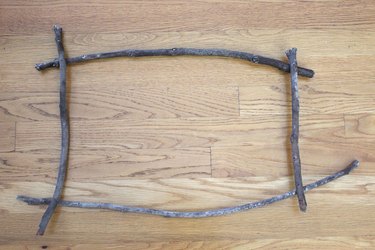
2. Secure the corners
At the corners where the twigs meet, place a dab of hot glue between them to lock them in place. The hot glue is not enough to secure these corners, but it will keep everything in place while you wrap twine around them.

Crisscross twine around the corners and tie the ends of the twine together in a knot. If you don't have twine or you want to add another color element, you can use a piece of yarn.

After you wrap twine around all four corners, the frame of the weaving loom will be solid.

3. Create the twine grid
We'll be forming a grid of twine within the loom that will allow us to insert flowers and shrubbery into it. There will be both vertical rows of twine and horizontal rows. This allows you to weave the botanical elements in either direction.
Start with the twine running vertically. Tie a knot with the twine about 2 inches from the top left corner.

Then, stretch the twine down to the opposite twig and tie a knot about 2 inches from the bottom left corner.

Move 2 inches to the right and tie a knot. Then, go to the opposite side and tie a knot.
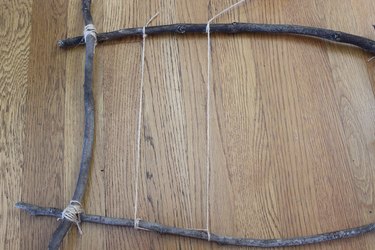
Continue this pattern until you have vertical rows of twine throughout the twig frame.
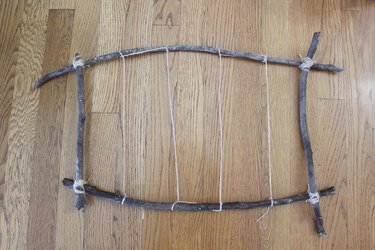
Now, let's move on to the horizontal rows of twine. Because of the rectangular shape of the frame, the left and right sides of the frame are shorter. Therefore, the rows of twine will be arranged closer together to fit in more rows. Start on the left about an inch from the bottom or top corner and tie a knot at the end of a piece of twine. Then, take the twine to the opposite side and tie a knot.
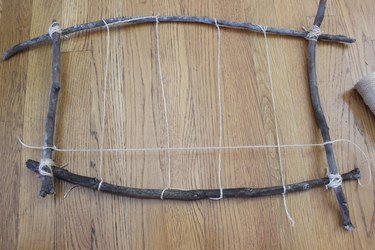
Move the twine an inch up that twig and tie a knot. Stretch the twine to the other side, tie a knot and so on until you have a complete grid of horizontal and vertical rows of twine.
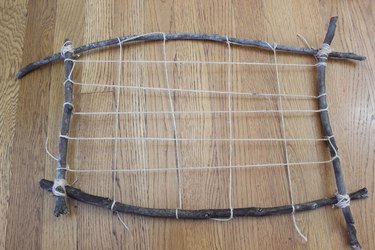
4. Weave in the foliage
Foraging for leaves either while camping or in your own background can be quite an activity of discovery, as you'll learn to appreciate natural elements you may otherwise overlook. Foliage works so well in this weaving project because it provides a beautiful backdrop to the flowers we'll add later, and leaves dry nicely within the loom. Try to collect a variety of foliage for visual interest. With your first sprigs of foliage, start weaving them vertically or horizontally in the loom. To make sure they stay attached, each element needs to be woven so it crosses at least three rows of twine—under a row, over a row and under another.
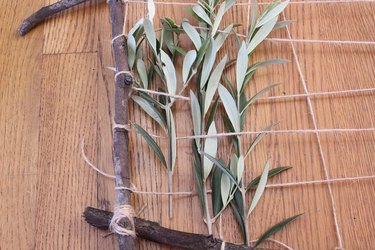
Continue weaving different varieties of natural items within the twine grid. Here you'll see the leaves foraged from my own yard: olive, eucalyptus and lemon. As you can see, even before the flowers are added, the nature loom looks stunning.

5. Weave the flowers
Flowers add color and beauty to our nature art. But what kind of flowers work best? If you are planning on continuing to change the nature loom, you can use any type of flower because if the flowers wilt, you will be replacing them anyway. If your goal is to create a dried arrangement within the loom, then you'll want to select flowers that will stay intact when dried. Flowers such as baby's breath, roses, lavender, strawflowers and pompoms dry well.
As you did with the foliage, weave stems of flowers throughout the loom, passing the stems between at least three rows of twine. I selected three types of flowers: roses, baby's breath and big blue sea holly.


Although you can display your finished art project immediately, to properly preserve the flowers so they dry properly, you'll want to turn the loom so the flowers are upside down. Drying them in a dark room also helps preserve the color of the flowers.
However, if the immediate gratification of admiring your nature loom is the top priority (and for kids, making them wait for flowers to dry could be a deal breaker), go ahead and display it as is. If certain blooms don't dry as well as others, just remove them from the loom and add some fresh flowers.
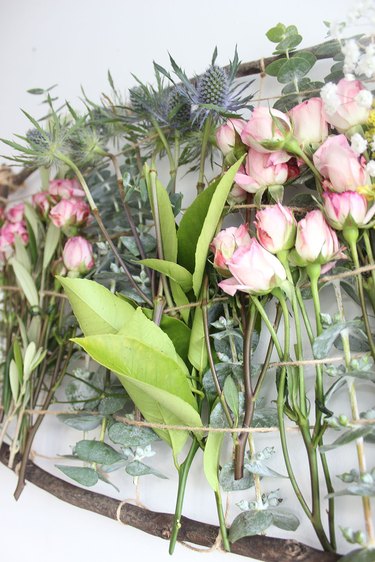
That's one of the great things about this nature loom. It's living art and can constantly evolve—just like nature.